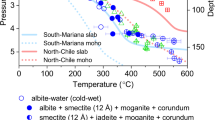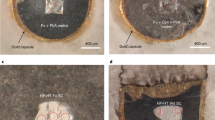Abstract
Strong evidence exists that water is carried from the surface into the upper mantle by hydrous minerals in the uppermost 10–12 km of subducting lithosphere, and more water may be added as the lithosphere bends and goes downwards. Significant amounts of that water are released as the lithosphere heats up, triggering earthquakes and fluxing arc volcanism1. In addition, there is experimental evidence for high solubility of water in olivine, the most abundant mineral in the upper mantle, for even higher solubility in olivine’s high-pressure polymorphs, wadsleyite and ringwoodite2, and for the existence of dense hydrous magnesium silicates that potentially could carry water well into the lower mantle3 (deeper than 1,000 km). Here we compare experimental and seismic evidence to test whether patterns of seismicity and the stabilities of these potentially relevant hydrous phases are consistent with a wet lithosphere. We show that there is nearly a one-to-one correlation between dehydration of minerals and seismicity at depths less than about 250 km, and conclude that the dehydration of minerals is the trigger of instability that leads to seismicity. At greater depths, however, we find no correlation between occurrences of earthquakes and depths where breakdown of hydrous phases is expected. Lastly, we note that there is compelling evidence for the existence of metastable olivine (which, if present, can explain the distribution of deep-focus earthquakes4,5,6,7) west of and within the subducting Tonga slab8 and also in three other subduction zones, despite metastable olivine being incompatible with even extremely small amounts of water (of the order of 100 p.p.m. by weight7). We conclude that subducting slabs are essentially dry at depths below 400 km and thus do not provide a pathway for significant amounts of water to enter the mantle transition zone or the lower mantle.
This is a preview of subscription content, access via your institution
Access options
Subscribe to this journal
Receive 51 print issues and online access
$199.00 per year
only $3.90 per issue
Buy this article
- Purchase on Springer Link
- Instant access to full article PDF
Prices may be subject to local taxes which are calculated during checkout

Similar content being viewed by others
References
Ulmer, P. & Trommsdorff, V. Serpentine stability to mantle depths and subduction related magmatism. Science 268, 858–861 (1995)
Smyth, J. R., Frost, D. J., Nestola, F., Holl, C. M. & Bromiley, G. Olivine hydration in the deep upper mantle: effects of temperature and silica activity. Geophys. Res. Lett. 33, 1530 L15301. (2006)
Angel, R. J. et al. Stabilities and equations of state of dense hydrous magnesium silicates. Phys. Earth Planet. Inter. 127, 181–196 (2001)
Green, H. W. & Burnley, P. C. A new self-organizing mechanism for deep-focus earthquakes. Nature 341, 733–737 (1989)
Green, H. W., Young, T. E., Walker, D. & Scholz, C. H. Anticrack-associated faulting at very high pressure in natural olivine. Nature 348, 720–722 (1990)
Green, H. W. & Houston, H. The mechanics of deep earthquakes. Annu. Rev. Earth Planet. Sci. 23, 169–213 (1995)
Diedrich, T., Sharp, T. G., Leinenweber, K. & Holloway, J. R. The effects of small amounts of H2O on olivine to ringwoodite transformation growth rates and implications for subduction of metastable olivine at 18 GPa. Chem. Geol. 262, 87–99 (2009)
Chen, W.-P. & Brudzinski, M. Evidence for large-scale remnant of subducted lithosphere beneath Fiji. Science 292, 2475–2478 (2001)
Ranero, C. R., Phipps Morgan, J., McIntosh, K. & Reichert, C. Bending-related faulting and mantle serpentinization at the Middle America trench. Nature 425, 367–373 (2003)
Dixon, T. H, Moore, J. C., eds. The Seismogenic Zone of Subduction Thrust Faults 147–315 (Columbia Univ. Press, 2007)
Hacker, G. R., Peacock, S. M., Abers, G. A. & Holloway, S. D. Subduction factory: 2. Are intermediate depth earthquakes in subducting slabs linked to metamorphic dehydration reactions? J. Geophys. Res. 108, 2030 (2003)
Brudzinski, M. R., Thurber, C. H., Hacker, B. R. & Engdahl, R. Global prevalence of double Benioff zones. Science 316, 1472–1474 (2007)
Peacock, S. M. Are the lower planes of double seismic zones caused by serpentine dehydration in subducting oceanic mantle? Geology 29, 299–302 (2001)
Zhang, H. et al. High-resolution subducting-slab structure beneath northern Honshu, Japan, revealed by double-difference tomography. Geology 32, 361–364 (2004)
Bostock, M. G., Hyndman, R. D., Rondenay, S. & Peacock, S. M. An inverted continental Moho and serpentinization of the forearc mantle. Nature 417, 536–538 (2002)
Brudzinski, M. R. & Chen, W.-P. Earthquakes and strain in subhorizontal slabs. J. Geophys. Res. 110, B08303 (2005)
Raleigh, C. B. & Paterson, M. S. Experimental deformation of serpentinite and its tectonic implications. J. Geophys. Res. 70, 3965–3985 (1965)
Jung, H., Green, H. W. & Dobrzhinetskaya, L. F. Intermediate-depth earthquake faulting by dehydration embrittlement with negative volume change. Nature 428, 545–549 (2004)
Zhang, J., Green, H. W., Bozhilov, K. & Jin, Z.-M. Faulting induced by precipitation of water at grain boundaries in hot subducting oceanic crust. Nature 428, 633–636 (2004)
Iidaka, T. & Furukawa, Y. Double seismic zone for deep earthquakes in the Izu-Bonin subduction zone. Science 263, 1116–1118 (1994)
Kohlstedt, D. L., Keppler, H. & Rubie, D. C. Solubility of water in the α, β and γ phases of (Mg,Fe)2SiO4. Contrib. Mineral. Petrol. 123, 345–357 (1996)
Bolfan-Casanova, N., McCammon, C. A. & Mackwell, S. J. Water in Transition Zone and Lower Mantle Minerals 57–68 (Geophys. Monogr. 168, American Geophysical Union, 2006)
Iidaka, T. & Suetsugu, D. Seismological evidence for metastable olivine inside a subducting slab. Nature 356, 593–595 (1992)
Green, H. W. & Marone, C. J. in Plastic Deformation of Minerals and Rocks (eds Wenk, H.-R. & Karato, S.) 181–199 (Mineralogical Society of America, 2002)
Wiens, D. A., McGuire, J. J. & Shore, P. J. Evidence for transformational faulting from a deep double seismic zone in Tonga. Nature 364, 790–793 (1993)
Mosenfelder, J. L. et al. Experimental constraints on the depth of olivine metastability in subducting lithosphere. Phys. Earth Planet. Inter. 127, 165–180 (2001)
Kaneshima, S., Okamoto, T. & Takenaka, H. Evidence for a metastable olivine wedge inside the subducted Mariana slab. Earth Planet. Sci. Lett. 258, 219–227 (2007)
Jiang, G., Zhao, D. & Zhang, G. Seismic evidence for a metastable olivine wedge in the subducting Pacific slab under Japan Sea. Earth Planet. Sci. Lett. 270, 300–307 (2008)
Stalder, R. & Ulmer, P. Phase relations of a serpentine composition between 5 and 14 GPa: significance of clinohumite and phase E as water carriers into the transition zone. Contrib. Mineral. Petrol. 140, 670–679 (2001)
Iizuka, Y. & Nakamura, E. Experimental study of the slab-mantle interaction and implications for the formation of titanoclinohumite at deep subduction zone. Proc. Jpn. Acad. B 71, 159–164 (1996)
Toffelmier, D. A. & Tyburczy, J. A. Electromagnetic detection of a 410-km-deep melt layer in the southwestern United States. Nature 447, 991–994 (2007)
Hirschmann, M. M. Water, melting and the deep Earth water cycle. Annu. Rev. Earth Planet. Sci. 34, 629–653 (2006)
Tseng, T.-L. & Chen, W.-P. Discordant contrasts of P- and S-wave speeds across the 660-km discontinuity beneath Tibet: a case for hydrous remnant of sub-continental lithosphere. Earth Planet. Sci. Lett. 268, 450–462 (2008)
Acknowledgements
We thank L. Dobrzhinetskaya, P. Silver, J. Smyth, T.-L. Tseng, H. Zhang and J. Zhang for discussions. H.W.G. thanks D. LeFay for technical support. This work was supported by NSF grants EAR0552011, EAR-0652626, EAR-0125938 (H.W.G.), EAR9909362, EAR0551995 (W.-P.C.) and EAR552002 (M.R.B.). W.-P.C. acknowledges a distinguished visiting professorship, funded by the National Science Council of Taiwan, at the Academia Sinica.
Author information
Authors and Affiliations
Contributions
The concepts underlying this paper have developed through discussions among the authors over the last few years. Interpretation of experimental results is primarily due to H.W.G.; global seismic results and artwork are primarily due to W.-P.C. and M.R.B. H.W.G. wrote the first draft of the manuscript; all authors participated in manuscript revision.
Corresponding author
Ethics declarations
Competing interests
The authors declare no competing financial interests.
Supplementary information
Supplementary Information
This file contains Supplementary Text on Abundance of DHMS in deep Slabs and Potential Rehydration of the Upper Slab by Subsequent Dehydration of the Slab's Interior. The file also contains additional references and Supplementary Figure 1 with a legend. (PDF 134 kb)
PowerPoint slides
Rights and permissions
About this article
Cite this article
Green II, H., Chen, WP. & Brudzinski, M. Seismic evidence of negligible water carried below 400-km depth in subducting lithosphere. Nature 467, 828–831 (2010). https://doi.org/10.1038/nature09401
Received:
Accepted:
Published:
Issue Date:
DOI: https://doi.org/10.1038/nature09401
This article is cited by
-
Detection of thin film phase transformations at high-pressure and high-temperature in a diamond anvil cell
Communications Earth & Environment (2024)
-
Heterogeneous slab thermal dehydration driving warm subduction zone earthquakes
Scientific Reports (2023)
-
Sea-level stability over geological time owing to limited deep subduction of hydrated mantle
Nature Geoscience (2022)
-
Unsupervised machine learning reveals slab hydration variations from deep earthquake distributions beneath the northwest Pacific
Communications Earth & Environment (2022)
-
Dry metastable olivine and slab deformation in a wet subducting slab
Nature Geoscience (2021)
Comments
By submitting a comment you agree to abide by our Terms and Community Guidelines. If you find something abusive or that does not comply with our terms or guidelines please flag it as inappropriate.



